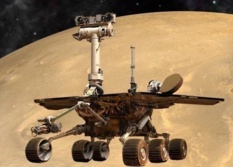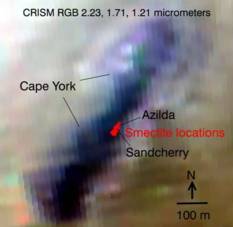A.J.S. Rayl • Apr 02, 2013
Mars Exploration Rovers Update: Opportunity Hunkers Down for Solar Conjunction, Final Science on Matijevic Hill
Sols 3236 - 3265
As the Mars Exploration Rover (MER) mission trekked further into its tenth year of exploring the Red Planet, Opportunity spent the month of March finishing up its science investigations on Matijevic Hill while the operations team on Earth prepared for the upcoming solar conjunction, and MER science team members headed for Texas for the 44th annual Lunar and Planetary Science Conference (LPSC) to report on the robot field geologist's findings at Endeavour Crater.
The most anticipated talk at LPSC's MER session, especially with MER Principal Investigator Steve Squyres' repeated billboarding of it, was given by Ray Arvidson, MER deputy principal investigator of Washington University St. Louis, and it turned out to be the tour de force of the afternoon. In a subtle "barn burner" of a presentation, the most traveled living Mars geologist explained how the team is making up for Opportunity's non-functioning mineral detecting instruments by enlisting the Compact Reconnaissance Imaging Spectrometer for Mars (CRISM) onboard the Mars Reconnaissance Orbiter (MRO), and how the rover has indeed found the clay minerals that the orbital instrument first discovered in 2009.
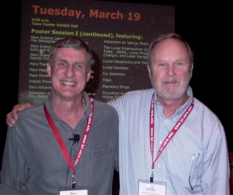
Steve Squryes and Ray Arvidson
Mars Exploration Rovers' Principal Investigator Steve Squyres, of Cornell University, and Deputy Principal Investigator Ray Arvidson, of Washington University St. Louis, indulged the MER Update and smiled for the camera just before the MER session at this year's Lunar and Planetary Science Conference (LPSC). It was only half an afternoon, but the presentations by Eldar Noe Dobrea (Planetary Science Institute); Larry Crumpler (New Mexico Museum of Natural History & Science); a sequestered Ken Herkenhoff (USGS Astrogeology Science Center) 'channeled' by Arvidson; Bill Farrand (Space Science Institute); Barbara Cohen (NASA MSFC); Squyres, and Arvidson on Opportunity's findings since arriving at Endeavor Crater packed a wallop – and the room.A.J.S. Rayl
Arvidson, who is also a co-investigator on the CRISM team, spent countless hours studying Cape York and meticulously mapping the smectite signature detected by MRO's visible infrared spectrometer on Matijevic Hill. He ultimately produced a pixel-by-pixel map for vetting at the annual science gathering, which is presented here.
Although there has been some confusion in news reports, Arvidson seemed to clearly convince his colleagues in the community at LPSC that Opportunity, with CRISM, succeeded in logging another first for the history books, roving beyond MER's initial science objectives and ground-truthing the presence of the smectite clays at the 20-kilometer diameter Endeavour Crater, in a layer of the oldest bedrock the rover has ever come across, known as Whitewater Lake.
"That's where the clays are," Squyres unequivocally told the MER Update, from his office at Cornell University. "The CRISM data are solid. The rover's ground observations are consistent with what we would expect to find. This is a great example of synergy between two projects, two spacecraft. Each is able to complement the other in a way that the whole becomes greater than the sum of its parts. There's no question that Whitewater Lakes is where the clays are. The combination of the two is – case closed. And we'll have more to say about that when we're ready."
Opportunity, meanwhile, is hunkering down at an outcrop called Big Nickel to complete its final science investigation on Matijevic Hill, which is located along the inboard side of the Cape York segment of Endeavour Crater's rim, and to wait out solar conjunction. But in closing his own LPSC talk, an overview of the rover’s exploration of those clay-bearing materials at Endeavour, Squyres announced that once solar conjunction is over, the robot field geologist will depart Matijevic Hill and "head to the south" for Solander Point, news that MER followers around the world have been anticipating and no doubt cheered.
Solar conjunction is a recurring celestial event that occurs once every 26 months or so when the Sun comes between Earth and Mars. During this period, the Sun basically gets in the way and compromises communications links; therefore, the team will suspend all new commands between April 9th and April 26th and effectively put Opportunity in automode.
"We’re getting ready for solar conjunction now, which pretty much starts the end of the first week in April," reported John Callas, MER project manager at the Jet Propulsion Laboratory (JPL), where all the American Mars rovers have been "born" and from which they are managed. "The rover has to do everything on its own during that time period. But that’s all coming together." The engineers will complete uploading the rover's automode work schedule the first few days of April, he said.
Opportunity actually began March 2013 at Big Nickel, checking out a boxwork vein given the nifty name of Lihir. From there, the rover headed back to Kirkwood, the fin-bearing outcrop that first drew the MER scientists to Matijevic Hill last August.
Named for the inimitable Mars rover pioneer Jake Matijevic, who passed away in August 2012, the hill has provided a bounty of findings and Martian riches as reported in previous MER Updates, not the least of which are the clay minerals, the smectite.
The science team decided to return to Kirkwood to have the rover further investigate the mysterious newberries, small spherules that resemble – but are nothing like – the hematite-rich concretions that are known as blueberries, which the rover found on landing and throughout the Meridiani Planum area it's traversed. There, in a section of the outctop dense with the spherules, Opportunity conducted an old-fashioned, geologist's streak test.
A streak test, as described in last month's MER Update, involves rubbing a rock across a white plate or surface to break part of the rock into particles or tailings. From the color of those tailings, geologists can often determine a rock's mineral composition or at least part of it. Thinking that perhaps the outer, "crunchy" part of these new spherules might contain a bit of hematite, the scientists were looking for the distinctive red color left behind in tailings of rocks or geologic formations containing hematite.
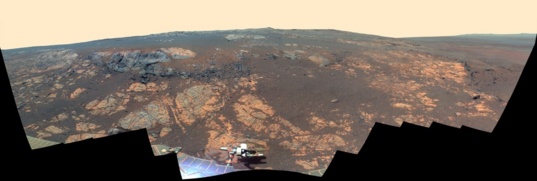
NASA / JPL-Caltech / Cornell / Arizona State University
Matijevic Hill Panorama
Opportunity took the hundreds of component images for this panorama with her stereo panoramic camera (Pancam) from Nov. 19, 2012 through Dec. 3, 2012. Named in honor of JPL's Jake Matijevic, one of the creators of Spirit and Opportunity and a Mars rover pioneer, the hill is an area within the Cape York segment of Endeavour's rim. Jake passed away on Aug. 20, 2012, shortly after Curiosity landed. "It's still very hard," said Ashley Stroupe, one of the rover planners, during an interview this month. "We're here exploring Matijevic Hill, so his name is in our minds every day. A day doesn't go by when we have a question and know the person who would know that answer off the top of his head was Jake. We miss him tremendously. It's a terrible loss for everybody and Mars exploration in general. He was one of the incredible people behind the whole program."As Squyres had noted last month, it wouldn't have to take a lot of hematite to produce the telltale reddish particles. But Mars gave them a surprise: the tailings were violet-to-purplish. Although quartz and fluorite are known to produce such a color, the scientists are still working on their hypotheses and all Squyres would say is: "Don't know. Don't know. Don't know." But he did note in his LPSC presentation that the newberries are slightly enriched in iron relative to the other areas, something that hints of hematite, and he did confirm the tailings are "kind of purplish."
From Kirkwood, Opportunity returned to Big Nickel and another boxwork vein in the outcrop, now known as Esperance, positioned just a couple centimeters from the original target, Lihir. "We went back because our first quick look at the chemistry there looked very, very interesting, and we're going to give it another look," said Squyres, who made the call to track back.
The rover will spend solar conjunction, hence most of April, at Esperance. "As soon as conjunction is over, we'll be heading south to Solander Point as quickly as we can," Squyres re-confirmed for the MER Update last Friday.
As Opportunity hunkers down at Esperance for its final investigation on Matijevic Hill, the future looks as bright as one could expect for this veteran explorer.
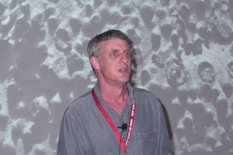
Newberry Man
The spherules Opportunity has found on Matijevic Hill remain a mystery. But with the rover's work in March, clues are emerging. It turns out, MER Principal Investigator Steve Squyres said at this year's Lunar & Planetary Science Conference (LPSC) that a densely packed berry patch on Kirkwood revealed a slight enrichment of iron. Stay tuned. "/Mars is trying to tell us something," he said.A.J.S. Rayl
The rover continues to "perform well," said Bill Nelson, chief of the MER rover engineering team, even though it did experience a glitch in March, which may or may not be related to its intermittent Flash memory issue. This Flash issue involves corruption of sectors in the memory and is much like the one Spirit experienced years ago. The degradation must get worse and impact many sectors before the team engineers can successfully execute a full reformat, as previously reported here, and as they did successful with Spirit.
This time around however, the symptoms were different. "We were doing some file transfers to flash, and got some errors," said Callas. "This is different from amnesia events, which occur when the rover wakes up and the Flash memory doesn’t mount. We don’t know what it means. But it is a different symptom."
This glitch, which occurred in the second week of March, may have been a simple timing problem not related to that memory system, Nelson conjectured. "The most likely scenario is that the file exists, but has zero length. We haven’t put a lot of effort yet into investigating because we've been focused on clearing out our Flash in preparation for solar conjunction," he said. "In any case, this is not a particularly serious problem. It affects only a single file. And basically it means that whatever data was supposed to be in that file is effectively missing. There’s really not much we can do to try to recover it. It’s just missing. And there may have never been any data there to begin with." So far the scientists aren't missing anything. The likely fix, he said, is "to just stop asking for it and delete the file from the directory."
Mars, however, brought good news to Opportunity in March, informed Callas, whipping up three summer dust-gusters that cleared several layers of accumulated dust from its solar arrays, enabling the robot field geologist to go into solar conjunction with plenty of power. "We are in very good shape for solar conjunction," Nelson added. If all goes as hoped, Opportunity will be able to grind into Esperance and then place her chemical detecting alpha particle X-ray spectrometer (APXS) on the target for a good long integration or analysis through the nearly three weeks of Sun blocked communications.
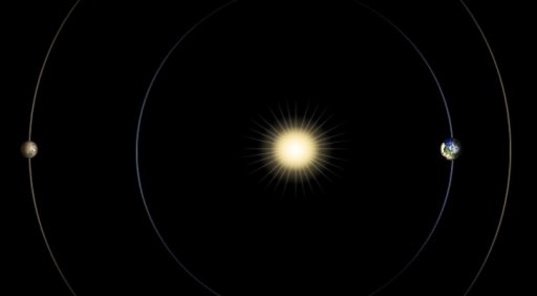
NASA / JPL
Solar conjunction coming soon
About every 26 months, when Mars and Earth are on opposite sides of the Sun, communication between the two planets is disrupted. During the days surrounding such an alignment, which is called a solar conjunction, the Sun can disrupt radio transmissions between the two planets and so the MER team will stand down from all but a few minimal communications, from April 8-16th this year, and Opportunity will go on 'autopilot' working a science light campaign."Opportunity is doing great. The team is doing great," Nelson summed up. "Once communication is restored, we're all excited to get the rover on the road to Solander Point."
If it's March, it's LPSC
Conspicuous by their absence at LPSC this year were most of the government employees who have been effectively "sequestered" as a result of the embarrassing failure of the U.S. Senate and House of Representatives to do their jobs, find a way to compromise, and deal with a budget deficit that skyrocketed as a result of wars in Iraq and Afghanistan, among other things. Though NASA's James Green Director of the Planetary Science Division, appearing via satellite link, tried to assure the audience at the space agency's LPSC briefing that the legislators were "working hard," scoffs and mutterings of disbelief and disgust could be heard throughout the room.
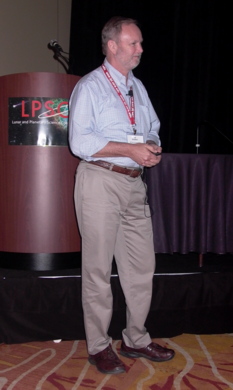
Ray Arvidson at LPSC
Ray Arvidson is the James S. McDonnell Distinguished University Professor at Washington University St. Louis, and Deputy Principal Investigator of MER, and the most traveled living Mars geologist, beginning with Viking. In his tour de force presentation at LPSC, he explained how the team is making up for Opportunity's nonfunctioning mineral detecting instruments by enlisting the Compact Reconnaissance Imaging Spectrometer for Mars (CRISM) onboard the Mars Reconnaissance Orbiter (MRO), and how with it the rover has indeed found the clay minerals that the orbital instrument first discovered in 2009.A.J.S. Rayl
Washington's "hard work" on a budget has yet to produce anything, leaving to suffer, once again, the very science and new technologies that could help the country maintain, or in some cases re-gain its leadership, inspire its youth, and help advance so many things here on terra firma. The restrictions are and will produce "deleterious effects on scientific productivity and on scientists’ and students’ careers," the American Astronomical Society opined in a news release in March.
Still, nothing could stop the energy and optimism of the rover teams. Not surprisingly, Curiosity claimed the rover spotlight at LPSC, held at The Woodlands the week of March 17th, with three special sessions and a press conference. Still, Steve Squyres, Ray Arvidson, and the MER scientists have been on the road with Opportunity and MER for nine years and counting, and ever since Spirit bounced onto the Martian surface, they have always filled the room and made the most of time given.
The MER science session, which was chaired by JPL's Matt Golombek, lasted only 1.5 hours and was tightly focused on Opportunity's findings at Endeavour Crater, the one time "dream destination," where the rover arrived in August 2011 after a three-year journey from Victoria Crater across the plains of Meridiani Planum. Although Squyres was "on fire" as usual and is one of the best science communicators around, Arvidson delivered the tour de force of the day. In fact, he reminded the audience at least three times of "Ray's talk," which would close the session.
And when it came, as Arvidson described Opportunity's first ground-based observations of phyllosilicates on Mars aided by a new mineral detector that just happens to be in orbit, Squyres gave his deputy the moment, something else that makes the MER team special.
"Steve and I were waiting for reactions," Arvidson said in the days following the LPSC. "Mapping is pretty strong evidence to most people and that was the sense we both got talking to people afterward," he said. "The question is whether or not the spectra were convincing and the answer is, the community agreed that they were convincing … although people were a little bit confused about what Opportunity is saying.
"The easiest thing would have been to find the total composition of smectites and we’re not seeing that," Arvidson continued. "So what it indicates is that we have really low water-to-rock ratios, and the whole rock hasn't been turned into a clay. If you put basalt minerals into water, the first to kinetically dissolve will be the iron-bearing silicates, olivine and pyroxene, and they will release iron which can be removed by aqueous fluids, with some left to make smectite. It's simple kinetics," he explained.
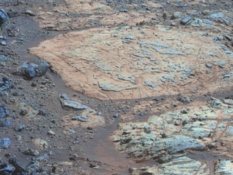
Original Whitewater Lake
Whitewater Lake is the large flat rock in the top half of the image. From left to right it is 0.8 meter (about 30 inches) across. The dark blue nubby rock to the lower left is Kirkwood, which bears non-hematite mystery spherules Steve Squyres dubbed newberries. The rocks to the lower right look like breccias, a type of rock containing jumbled fragments cemented together. They resemble other rocks in the area classed as the Shoemaker formation, hypothesized to hold deposits of material ejected when an impact excavated Endeavour Crater billions of years ago.NASA / JPL / Cornell / Arizona State University
On Earth, a tiny amount of corrosion of those minerals that produce smectites doesn't alter the chemistry much at all, but it does change the phases of the mineral. "Unfortunately, on Opportunity we don't have Mini-TES or Mössbauer to really pin down the presence of the smectite phase, so we have to use CRISM as our mineral detector," Arvidson said.
"The orbital CRISM data is not circumstantial," he underscored. "Opportunity meanwhile has given us direct evidence that we have found something interesting and different than we've seen otherwise, and, it is consistent, circumstantially, with clay minerals, smectites – finely layered deposits on very fine-grained Whitewater Lake rocks, covered with these strange coatings in some places that we have not seen before, and they have been pretty extensively cut and filled in with gypsum veins."
Additionally, the chemistry is different than the rest of Cape York, in that it is more enriched with aluminum and silicon, Arvidson pointed out. "Which is what you'd find if you take basalt and put it in water, neutral water. It would tend to kinetically dissolve the olivine and pyroxene faster than the feldspar. If you keep most of the elements there, and remove a little of the ferrous-bearing cations – that is, magnesium, iron and calcium – and put the rest of it into smectite – voila! You've cooked up what we see, so everything goes together in the model."
"I think Ray showed this compellingly that the clay signature at Cape York is directly locked up in this little window into the subsurface that we found at Matijevic Hill," Squyres said later. And most every planetary scientist and geologist we talked with at LPSC seemed to agree. "There were a lot of good vibes afterward," said Arvidson.
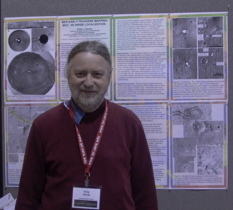
Philip J. Stooke
From International Atlas of Mars Exploration: The First Five Decades to his LPSC poster this year to an advance copy of International Atlas of Mars Exploration - Spirit to Curiosity: 2004 to 2014, still a work in progress, Stooke's attention to detail and the endless hours of painstaking work that have gone into the efforts are as obvious as they are jaw-droppingly impressive. "But this isn't work," the associate professor at University of Western Ontario told the MER Update. "It's fun."AJ.S. Rayl
The other presenters, representing the work of dozens of scientists, had a lot to add about the veteran rover's most recent, and as it turns out, most significant findings since scoring the world's first 300-million-mile, interplanetary hole-in-one bouncing onto the surface in January 2004. A richer overview of that session will appear in next month's MER Update.
In the poster session Tuesday evening, March 19th, Philip J. Stooke's MER Early Traverse Mapping: MOC VS HiRISE Localization, was like a course in Cameras on Mars 101, revealing in a visual glance and quick read just how far orbital cameras, now routinely used by Mars rovers, have advanced since the days of the Mars Orbiter Camera onboard the Mars Global Surveyor. The HiRISE or High Resolution Imaging Science Experiment camera is onboard the Mars Reconnaissance Orbiter is used as a matter of course for charting Opportunity's travels.
A planetary cartographer and associate professor at the University of Western Ontario in Canada – and member of unmannedspaceflight.com – Stooke is the author of International Atlas of Mars Exploration: The First Five Decades (Cambridge University Press, Fall 2012), which stands as the most detailed visual reference and exhaustively researched chronology of trails blazed by Earthlings in the exploration of the Red Planet, beginning with Wernher von Braun's Mars Project, a technical specification for a manned expedition drafted in 1953, to Mars Express.
The poster actually offered a glimpse into Stooke's second volume: International Atlas of Mars Exploration - Spirit to Curiosity: 2004 to 2014. It will pick up where the first volume left off, will also be published by Cambridge University Press, and is slated to hit bookstore shelves in the fall of 2015.
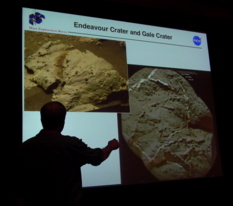
Steve Squyres presenting
"It's fascinating that we're seeing such similar things at the two sites," said Steve Squyres, who is Principal Investigator of MER and a co-investigator on the new rover's ChemCam. Here he showed vein-cut rock found by Opportunity at Endeavour and Curiosity at Gale Crater at this year's Lunar & Planetary Science Conference (LPSC).AJ.S. Rayl
The other "buzz" at LPSC was about the seeming uncanny similarities between what Opportunity is seeing at Endeavour and what Curiosity/Mars Science Laboratory is finding at Glenelg/Yellowknife Bay, in Gale Crater. "It's fascinating that we're seeing such similar things at the two sites," said Squyres, who is a co-investigator on the new rover's ChemCam. "We're looking farther into the past than we ever have with Opportunity now. These are the oldest rocks we've ever looked at, and they're dramatically different from anything we've ever seen, but astonishingly similar to what we're seeing at the Gale Crater site. So we're looking into a very early period in Martian history, where the conditions were really rather different from what appears to have been the case through most of the planet's history."
John Grotzinger, of Caltech, principal investigator for Curiosity and an MER science team member, agreed and was equally enthusiastic. "If you just have the pictures telling the story, it looks like the same story. But then when you get the payload and Opportunity can do the RATing, we could see what's below the surface there," he told the MER Update.
"I'm really excited about this, because I think we're going to be able to now start what I hope will become an emerging field of comparative planetary habitability," Grotzinger continued. "This is what we did on Earth decades ago. You start looking at really old rocks. In the beginning, everyone thinks the rocks you see must've formed the same way. Then you get a little more data and you find out – gosh – there are different formation mechanisms here. Then you look at a few decades later and suddenly realize that there's a lot of diversity in early environments on Earth. And while some things look the same, but when you get into the details they start to look different.
"What's cool about this now is Opportunity is finding things – not just with the sulfates – but at Matijevic Hill where it's at right now," Grotzinger said. "If you didn't know the whole story about how Mars has had these different ages and how things occurred at certain times, then you might think maybe these rocks were right next to each other. But here they are – separated by a broad difference and may be separated by time. So I'm excited that we may learn that some processes that involve water may repeat themselves or occur in different places. That could [enable us] to begin to get the guidebook to thinking about how aqueous alteration works on Mars and where the favorable places are for habitability."
What's "really cool," Grotzinger said, are the "themes" that are appearing. "Whether it was the sulfates at Meridiani, the rocks that probably have clays at Endeavour or the rocks that we know have clays at Gale, they all produced concretions. There are some themes going on here and we're seeing a cast of characters emerge that are familiar. Maybe through those common elements we can recognize the difference between environments … and get us into the [areas] that look like the more habitable environments."
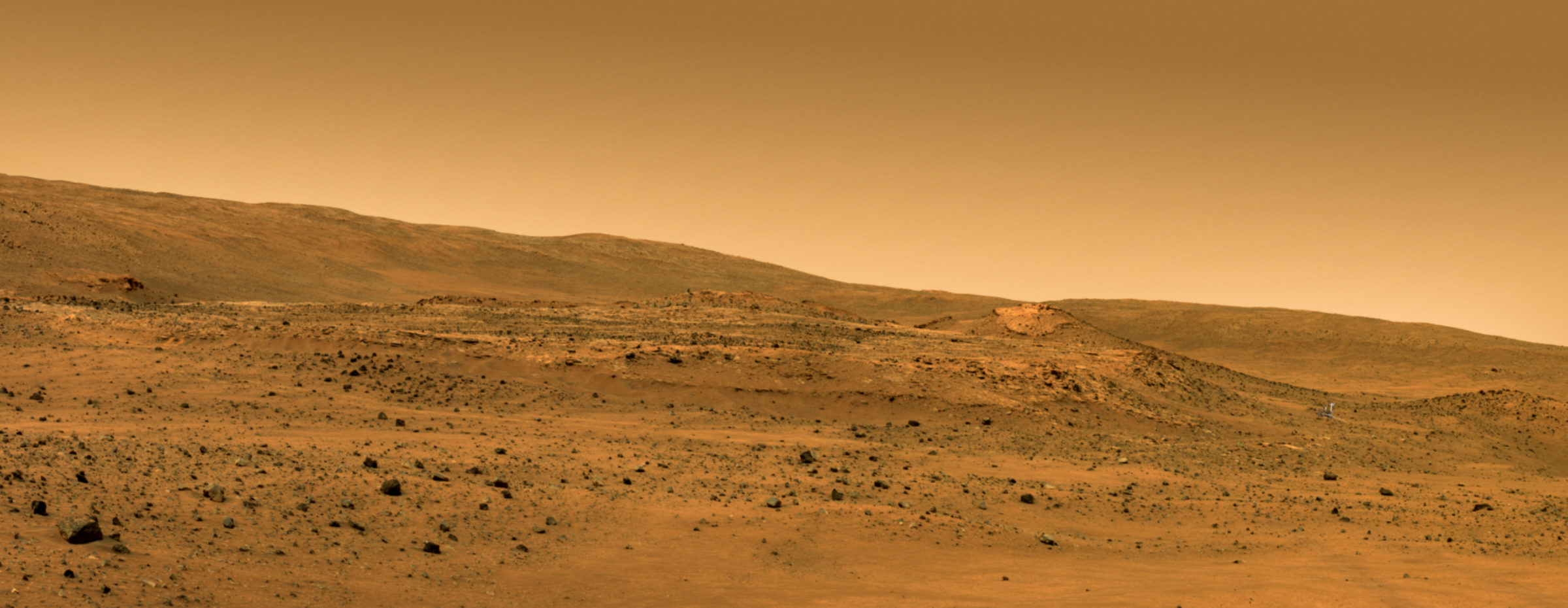
Opportunity from Meridiani Planum
Opportunity got off to a bit of a delayed start to the month of March because of a warm reset triggered by the flight software when she attempted to write into the Flash file system on Sol 3235 (Feb. 28, 2013). As a result of the reset, the rover stopped all active sequences that had been commanded at the Big Nickel site on Matijevic Hill, and automatically shifted into automode, a stable and safe state in which she would execute daily wake ups and communication sessions with both X-band and Ultra-High Frequency (UHF) relay with Mars Odyssey, but no active science sequences.
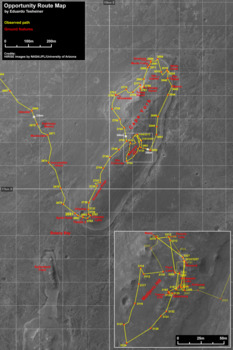
Opportunity route map
This is an up-to-date route map, produced by Eduardo Tesheiner, of Unmanned Space Flight.com (UMSF). It includes a zoom of the most relevant features around the Matijevic Hill area. The route path in the zoom is little bit "cluttered" because of the back-and-forth between some of the sites, making some folks at UMSF call this area "Benny Hill," after the famed the British comedian and television star. Tesheiner created this map from images taken by cameras onboard the Mars Reconnaissance Orbiter.NASA / JPL / UA / E. Tesheiner
The first day of March, the robot field geologist's Sol 3236, an expected X-band fault with the high-gain antenna occurred as a result of the reset, so she continued in automode.
The MER team sent real-time commands to Opportunity on Sol 3237 (March 2, 2013) to clear the faults, upload new sequences, and activate those new sequences. The commanding worked as expected and the rover returned to nominal operations under master sequence control. The rover engineers at JPL, meanwhile, continued vigilant watch of the Flash memory situation. Once the Flash situation deteriorates further, as explained in previous MER Updates, the engineers will reformat the Flash file system, as they did with Spirit, and they expect the memory will then be fully recovered.
The rover began the month was just under 500 watt-hours of power, and registered an atmospheric opacity or Tau of 0.798 and a solar array dust factor of 0.580, so she was ready to work and had plenty of energy.
Opportunity returned to science activity using instruments on her instrument deployment device (IDD) or robotic arm work on Sol 3239 (March 4, 2013). She first placed the Alpha Particle X-ray Spectrometer (APXS) on Lihir at Big Nickel for a short integration, then collected the multiple photographs with her Microscopic Imager (MI) for a mosaic of the same target, and followed that by another placement of the APXS for a longer integration.
With that science done, Opportunity drove over 108 feet (33 meters) due south on Sol 3240 (March 5, 2013), returning to a location called Kirkwood, to conduct some close-up investigations of the newberries seen before in this location.
During the second week of March, Opportunity experienced another glitch on Sol 3244 (March 9, 2013), but it appeared to be fairly minor, although this time the symptoms were different from the amnesia incidents, and may have involved the loss of some science data, or not. "We just got an error message that basically said an attempt to read a particular file ended with an unexpected end of file, and there are typically three possibilities for that," said Nelson. " One is that I told it to go read a file that didn’t exist. Another is that I told it to read a file that existed but had no data. And the third that I told it to go read a file that existed, but the file had corrupted data."
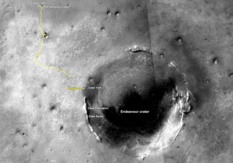
From Eagle to Endeavour
This image of Endeavour Crater was taken by the Malin Space Science Systems' Context Camera onboard the Mars Reconnaissance Orbiter (MRO). The yellow line on this map shows the route Opportunity took from Eagle Crater, where the robot field geologist landed in January 2004 (at the upper left end of the track) to a point about 3.5 kilometers (2.2 miles) away from the rim of Endeavour Crater. The rover arrived at the rim of 22-kilometer (14-mile) diameter hole in the ground in August 2011, after a threeyear journey from Victoria Crater. The rover entered by way of Spirit Point, an area named after her twin "sister," which stopped communicating in March 2010.NASA /JPL-Caltech / MSSS
How could the file be missing and corrupted? "The probable answer – although not necessarily the only one – is that we tried to write it and there was some sort of Flash problem that kept us from doing that successfully," responded Nelson. "We have nothing to prove that this in fact was the case, and there have been have other examples of this, where the rover thought there might be some data here, and there weren’t. So it’s not absolutely clear that this glitch truly is a Flash problem."
It could be that there is no such data and somehow it thinks there is, Nelson said. "It’s gone through a loop that says 'save off this data,' and so it saves off the data it has, which is nothing, creating a zero-length file. In other words, if it is told to create a file, it’ll do that. And if it’s told to put data in it but it has none, you’ve got a file with zero length. Which will then fail on the subsequent F-read," he explained.
It could be a timing problem, he said. "We create data we call EH and A. Engineering Housekeeping and Anomaly Data. This data is typically generated fairly frequently, and we can specify a sampling rate for it which is typically like once a minute or longer. But effectively what it does is creates a stream of data. We normally will send this data as we create it – this is our real-time, so-called channelized data stream," he said.
They also save this data, and so will fill up a buffer and then when the buffer gets to a certain size, they'll start a new buffer, and then wipe the old buffer. "It could happen that we have just written the old buffer," said Nelson. "We’ve started a new buffer, and the vehicle is told to shut down. We’ve finished our day and it’s time to close up shop for the night. And so the vehicle shuts down, and as part of that, it flushes these buffers. In other words, the signal to shut down and flush the buffer came right after the last buffer of data. And it hasn’t had time to accumulate more. That would also leave us with exactly the same scenario."
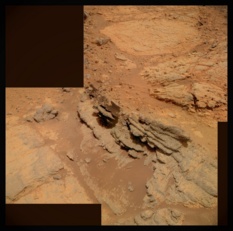
Kirkwood – Whitewater Lake
Opportunity took the images for this rich photograph of her September 2012 worksites. In the middle of the picture, you can see a part of the layered, sinuous-shaped outcrop the team dubbed Kirkwood. Just behind it, in the top part of the image is the fainter, circular, "slabby" flatter rock called Whitewater Lake, which the MER scientists concluded is part of a larger unit and the bearer of the phyllosilicate or smectite clay mineral signature detected by the Compact Reconnaissance Imaging Spectrometer for Mars (CRISM) onboard the Mars Reconnaissance Orbiter.NASA / JPL-Caltech / Cornell / ASU / S. Atkinson
So, what is most likely?
"Given that we have seen this problem on a few other sols, I’m of the belief that this is not a strong indicator that there’s really a Flash problem," Nelson ventured. "It could well be just a timing problem and these sorts of things happen from time to time. Again, I can’t prove that at this time, but I strongly suspect that. It’s just my engineering judgment." The engineers will continue to investigate this, he said.
On Sol 3246 (March 11, 2013), the rover approached the Kirkwood outcrop with a 9.2 meter (about 30-foot) drive. Although the robot field geologist had visited this site before the start of the Matijevic Hill walkabout, she returned for a more detailed investigation of the mystery newberries at this location. ?
Two sols later, 3248 (March 13, 2013), Opportunity took an MI finder frame image before placing her APXS on a newberry-rich surface target, called Sturgeon River2 for an overnight integration.?The next sol, she repositioned her IDD to collect another MI finder frame and place the APXS on the offset target Sturgeon River1a.
As the third week of the month took hold, the robot field geologist continued her in-situ investigation of the newberries on Sol 3250 (March 15, 2013), examining nearby targets. She took MI pictures for mosaics of targets named Lake Laurentian and South Range before placing the APXS back on Sturgeon River 1a for further integration. She performed the first of two geology streak tests, using her Rock Abrasion Tool (RAT) to grind the target Sturgeon River3.
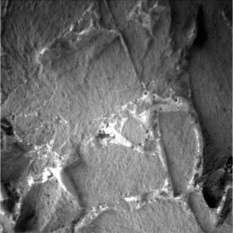
Where water once flowed
Opportunity took this close-up picture of the tiny veins running through the Whitewater Lake outcrop with her Microscopic Imager. Later data collected by the rover released that the veins are calcium sulfate. "It could be gypsum and it could be something else," said Squyres. "Our suspicion is that it's probably gypsum, but the calcium sulfate finding is solid. This is a big one," Squyres said earlier this year.NASA / JPL-Caltech
That grind did not generate sufficient rock dust so, Opportunity conducted another grind on Sol 3253 (March 19, 2013), and then followed that with the usual MI pictures and an overnight APXS integration. She also took a 13-filter Panoramic Camera (Pancam) image of the RAT dust. ??
"The rover used her RAT brush to conduct this streak test on Mars and create tailings," Nelson expounded. "Normally, we brush them the tailings out of the way so that we can look at the material underneath. But in this case we didn’t want to brush them out of the way. We wanted to image them and look at their color – and they were violet to purplish."
While the newberry tailings didn't produce hematite red particles hypothesized they might, the violet-purple color they produced is intriguing. Although the rover had to move on, the scientists will continue work on analyzing the data to try and determine just what the newberries are made of. "We can do a little bit of mineralogy with Pancam. If it's we have a big enough exposure, we can tell the difference between gypsum and hydrite, and we may be able to figure out what these purplish cuttings from the newberries mean," Squyres said.
"The streak test was neither here nor there in terms of convincing us that there was a nice red streak for hematite," said Arvidson. "But you don't need much hematite, just need a few percent and a little bit of cementation. It's grain-to-grain contacts where you just kind of get them cohesive because of a tiny amount of hematite, so the only evidence we have for enhanced hematite is the slight enrichment of iron that Steve mentioned at LPSC for the areas of higher concentrations of newberries."
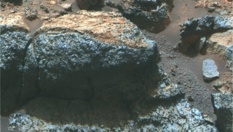
Newberries at Kirkwood
This Pancam mosaic shows part of the Kirkwood outcrop in false color to better distinguish the rock's features. Kirkwood, a wild, sinuous outcrop that sports fins, is what drew the MER science team members, along with the CRISM findings, to Matijevic Hill. This is the outcrop where the rover first found the new kind of spherules, or "newberries," as MER Principal Investigator Steve Squyres dubbed them. They are not the same as the hematite "blueberries" the rover found previously, and as of yet, the scientists don't know what they are. This photograph was processed by the Pancam team at Cornell and Arizona State University (ASU).NASA / JPL-Caltech / Cornell / ASU
From Kirkwood and its newberry patch, Opportunity roved straight north on Sol 3255 (March 21, 2013), for 25.53 meters (about 82 feet) and back to Big Nickel. This is where the robot field geologist would conduct the final in-situ investigation at Matijevic Hill, on another boxwork vein close to Lihir. Two sols later, she made a 4-meter (13-foot) drive to position herself near the Esperance surface target at Big Nickel.
"That approach was not quite good enough," noted Nelson. "Because we cannot move the IDD, the robot arm, from side to side [the shoulder azimuth joint is broken], we have to move the rover instead." So on Sol 3260 (March 26, 2013) Opportunity was commanded to perform the tiniest 2-centimeter (0.8-inch) bump, leaving her odometer at 35.65 kilometers (22.15 miles.) Finally she was where the scientists wanted her to be.
With Opportunity now precisely positioned for the coming three-week solar conjunction period, the plan ahead is to sequence the IDD to collect pictures for an MI mosaic of Esperance, just 2-3 centimeters below Lihir, and place the APXS for an overnight integration.
"Big Nickel is really interesting, featuring more aluminum than silica and it's very similar to an observation made by Spirit on Husband Hill, in a rock called Independence, which was our best bet chemically for a clay mineral there," said Arvidson. "But Mini-TES didn't see any bands, so Independence looked like a glassy material that was a clay wannabe but really hadn't crystallized."
What's of interest to the team is Lihir seems to have a composition similar to Independence, Arvidson said. "Since this is happening in a thick vein, it's indicative that this whole Whitewater Lake outcrop has seen water in many phases, water altering the bedrock, cutting the structure, putting in gypsum veins, and now what we think is this more boxwork-like vein at Big Nickel, which is enriched in aluminum and silica and down in iron, even compared to Whitewater Lake."
The MER scientists hope Opportunity will be able to use her RAT brush to grind into Esperance and then spend the nearly three weeks of solar conjunction analyzing the boxwork vein's chemical composition with its APXS.
In the meantime, during the last week of March, Opportunity's ops team discovered that Mars had given the rover a second wind on Sol 3254 (March 20, 2013), in the form of a relatively unusual summer dust-guster that cleared a layer or two of fine, reddish powder from the rover's solar arrays, said Callas.
As this rover's luck would have it, Mars repeated the favor two more times in the next three sols or Martian days, ramping up energy levels. "It boosted energy levels by about 100 watt hours, so we’re pushing just under 600 watt hours," said Callas late last week. The Tau or atmospheric opacity continued to decrease in March to 0.760, while the rover's solar array dust factor improved to 0.654 at month's end.
Broken shoulder, locked right front wheel, occasional "amnesia" events, a timing glitch here and there, and two non-functioning science instruments, the Mini-TES and Mössbauer, aside, "Opportunity has had no additional issues and continues to perform very well," Nelson said.
Esperance is to be the last in-situ target before the rover departs the Cape York segment of Endeavour Crater's rim. "As soon as conjunction is done we're going to tidy up things, take some images, and boogie off to Solander Point," said Arvidson, echoing Squyres announcement.
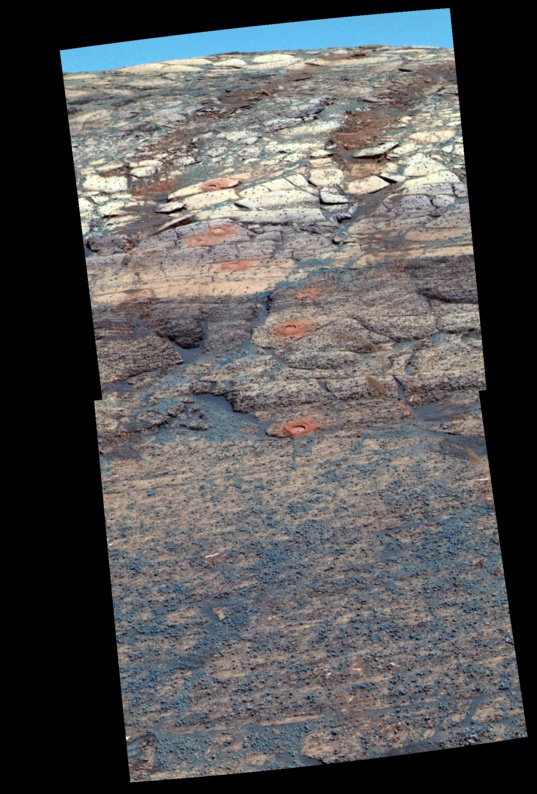
RAT tailings
Way back in the early days of the MER mission when Opportunity would grind into a "blueberry" it would leaves red tailings, as visible in the image above. While the science team believes the "newberries" at Endeavour Crater are distinctly different than the blueberries, it also plans on conducting a streak test on the "newberries" to see if by any chance they leave even a tiny bit of red tailings behind. That would mean the outer "crunchy coating of the newberries contains a bit of hematite. Stay tuned for the results.NASA / JPL-Caltech / Cornell


 Explore Worlds
Explore Worlds Find Life
Find Life Defend Earth
Defend Earth


